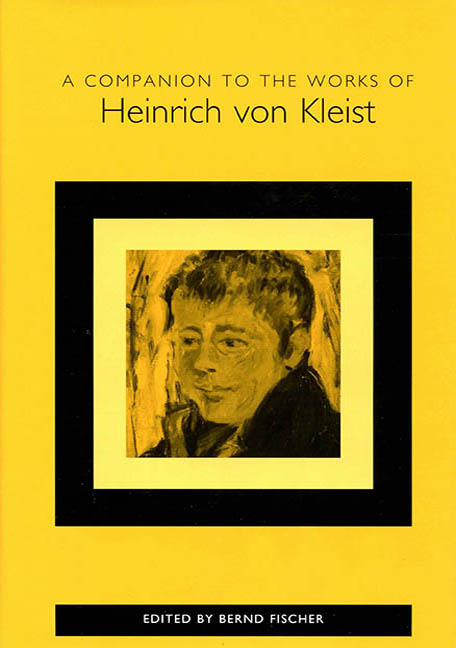Book contents
- Frontmatter
- Contents
- Introduction: Heinrich von Kleist's Life and Work
- Critical Approaches
- Language and Form
- Intellectual Paradigms
- Themes and Motifs
- Changing Color: Kleist's “Die Verlobung in St. Domingo” and the Discourses of Miscegenation
- Ripe Moments and False Climaxes: Thematic and Dramatic Configurations of the Theme of Death in Kleist's Works
- “Mein ist die Rache spricht der Herr”: Violence and Revenge in the Works of Heinrich von Kleist
- Notes on the Contributors
- Index
“Mein ist die Rache spricht der Herr”: Violence and Revenge in the Works of Heinrich von Kleist
from Themes and Motifs
Published online by Cambridge University Press: 27 April 2017
- Frontmatter
- Contents
- Introduction: Heinrich von Kleist's Life and Work
- Critical Approaches
- Language and Form
- Intellectual Paradigms
- Themes and Motifs
- Changing Color: Kleist's “Die Verlobung in St. Domingo” and the Discourses of Miscegenation
- Ripe Moments and False Climaxes: Thematic and Dramatic Configurations of the Theme of Death in Kleist's Works
- “Mein ist die Rache spricht der Herr”: Violence and Revenge in the Works of Heinrich von Kleist
- Notes on the Contributors
- Index
Summary
It is hardly surprising that in his review of Tieck's Dramaturgische Blätter Goethe should refer to Kleist as a writer who filled him with a sense of horror and disgust (Goldammer 53). For no one reading Kleist's literary works can fail to be struck by the wide variety of characters bent on exacting revenge at any price, ranging from the villainous Rupert in Die Familie Schroffenstein, who compels his family to swear vengeance against all the members of the house of Warwand, to the outraged Kohlhaas, who styles himself as the emissary of the Archangel Michael and insists, during his initial meeting with Luther, that it is his right to avenge himself against his enemy, the Junker. But despite the many instances of brutality in his works, Kleist goes out of his way to show that violence is not simply an inevitable fact about the human condition. On closer analysis, his fascination with wickedness has its roots in an elaborate theory of aesthetics and moral education and the belief that there is at least as much to be gained from the scrutiny of wickedness as there is from the contemplation of moral excellence. This view is spelled out most clearly in the humorous essay “Allerneuester Erziehungsplan,” in which the would-be director of the proposed “Lasterschule” urges prospective parents to shun the mimetic principle of moral education, the practice of trying to copy the behavior of exemplary cases of human virtue, in favor of a system of moral education based on what he terms the “law of contradiction.” By exposing his young charges to instances of human depravity, the would-be headmaster hopes to educate them to an understanding of virtue through the active rejection of vice (cf. Nobile 49–74). In devising such a program, Kleist displays his keen understanding of human psychology and, at the same time, shows that what is important in moral education is to dissuade human beings from simply embracing uncritically the moral precepts of others (however exemplary these may be) and, instead, to stimulate and encourage the development of an autonomous moral will. Accordingly, in confronting his readers with a wide range of perspectives on human wickedness in his literary works, Kleist is simply endorsing in his own aesthetic medium the pedagogical principles set out in his essay.
- Type
- Chapter
- Information
- A Companion to the Works of Heinrich von Kleist , pp. 227 - 248Publisher: Boydell & BrewerPrint publication year: 2003



